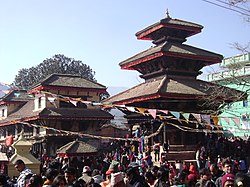Panauti
Panauti
पनौती | |
|---|---|
| Panauti Municipality | |
 | |
Nicknames:
| |
| Coordinates: 27°35′N 85°31′E / 27.583°N 85.517°E | |
| Country | Nepal |
| Province | Bagmati |
| District | Kavrepalanchok |
| Government | |
| • Type | Mayor–council government |
| • Mayor | Ram Sharan Bhandari |
| • Deputy Mayor | Gita Banjara |
| Area | |
• Total | 118.00 km2 (45.56 sq mi) |
| Population (2011) | |
• Total | 27,358.00 |
| • Density | 230/km2 (600/sq mi) |
| Time zone | UTC+5:45 (NST) |
| Postal code | 45209 |
| Area code | 011 |
| Website | www.panautimun.gov.np |
Panauti (Nepali: पनौती) is a municipality in Kavrepalanchok District in Bagmati Province of Nepal 32 km southeast of the capital, Kathmandu. A medieval architectural complex there was nominated by the Nepalese government as a UNESCO tentative site in 1996.[1]
Origin
[edit]At the end of the 13th century, Panauti was finally integrated into the unified kingdom of Nepal, along with Kathmandu, Patan, and Bhaktapur, which are all former capital cities of the Kathmandu valley. Panauti was a trading hub along the ancient Salt Trade route between Tibet and India. The recorded history of Panauti goes back to the first century AD. With the end of the Salt trade in the 1950s and the construction of the Arniko Highway in the 1960s bypassing the town, Panauti has gone into an economic rut.[2] Panauti, consists of a variety of Buddhist and Hindu religious monuments, and is called to be one of the area's most important medieval sites by Lonely Planet.[3]
Historical
[edit]

The Indreshwar temple is one of the largest and tallest pagoda style temples in Nepal. It was originally built over a lingam in 1294, making it the oldest surviving temple of Nepal. The roof struts embellishing the two lower stories of the temple are distinct Nepalese wood-carving and architecture. The upper section of the temple is hung with pots and pans, offerings from young married couples hoping for a happy and prosperous family life. The temple is in good condition and survived the 2015 earthquake. It is from this temple that the mystical third river of Panauti starts from leading to the Brahmayani temple across from the Tri Beni Ghats.[4]

Demographics
[edit]At the time of the 2011 Nepal census, Panauti Municipality had a population of 47,549. Of these, 68.6% spoke Nepali, 16.4% Tamang, 14.1% Newar, 0.2% Maithili, 0.1% Bhojpuri, 0.1% Hindi, 0.1% Thangmi and 0.1% other languages as their first language.[5]
In ethnicity/caste, 27.7% were Chhetri, 27.2% Hill Brahmin, 18.6% Newar, 17.4% Tamang, 1.5% Sarki, 1.4% DamaiDholi, 1.2% Kami, 1.0% Gharti/Bhujel, 0.8% Sanyasi/Dasnami, 0.7% Magar, 0.7% Pahari, 0.5% Rai, 0.4% Gurung, 0.1% Badi, 0.1% Danuwar, 0.1% Musalman, 0.1% other Terai, 0.1% Thakuri, 0.1% Thami and 0.2% others.[6]
In religion, 81.7% were Hindu, 16.1% Buddhist, 1.7% Christian, 0.1% Muslim and 0.3% others.[7]
In terms of literacy, 76.3% could read and write, 1.6% could only read and 22.0% could neither read nor write.[8]
Economy
[edit]Information Technology Park, Nepal is in Panauti municipality.
Gallery
[edit]-
Streets of Panauti
-
Panauti Temple
-
Panauti during Makar Mela
References
[edit]- ^ "The early medieval architectural complex of Panauti".
- ^ "Biku's Guide to Panauti". honeyguideapps.com. 11 September 2017. Retrieved 2017-10-10.
- ^ Lonely Planet. 2009. "Introducing Panauti".
- ^ "Travel Guide to Panauti | The Longest Way Home". thelongestwayhome.com. Retrieved 2018-05-16.
- ^ NepalMap Language [1]
- ^ NepalMap Caste [2]
- ^ NepalMap Religion [3]
- ^ NepalMap Literacy [4]





